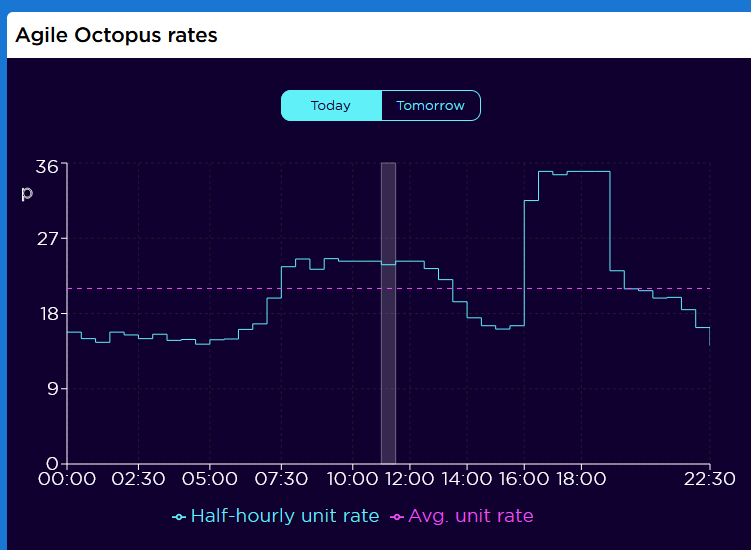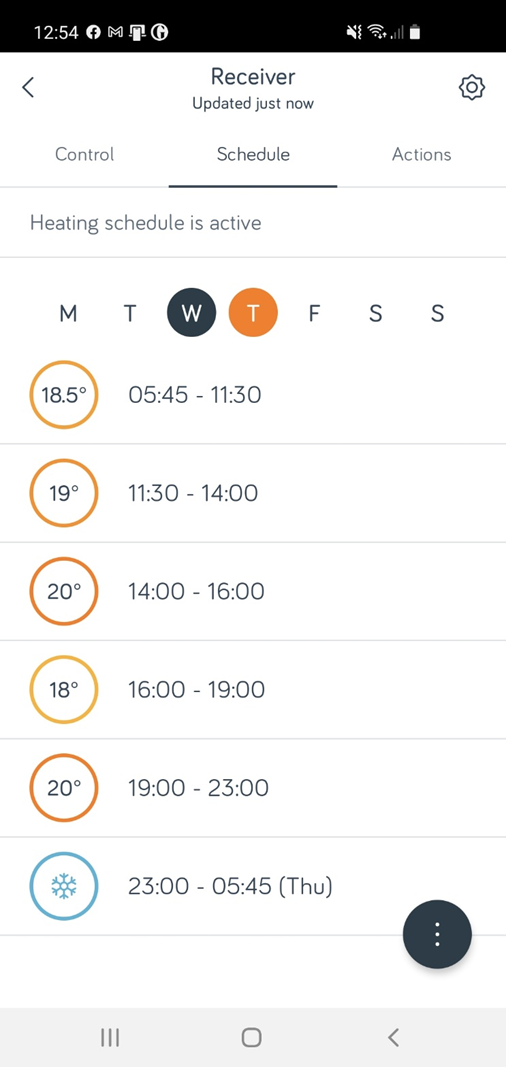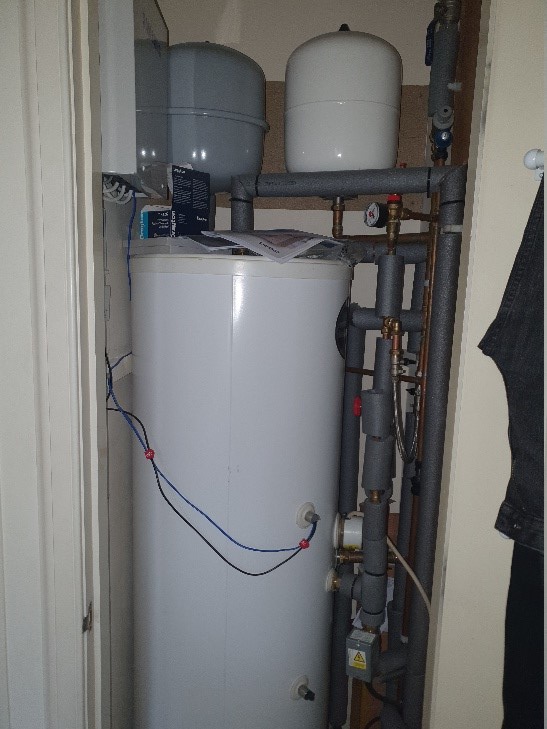Two winters with an air source heat pump, next step on our carbon reduction journey
Background
We bought a four bedroom detached property in East Lothian, Scotland from the builder in 1997. In November 2009 we had a solar PV system installed; 16 panels, 3.8 kW on a South facing roof. As a result of our free solar electricity in 2017 the next obvious step was to switch to an electric vehicle with Zappi charger to ensure we make the most of surplus solar power. We are now on our 2nd EV, a Hyundai Kona.
Original home heating system & switch to ASHP
The house was originally fitted with a 32kW condensing gas boiler, heating radiators throughout the house and controlled by a Hive internet connected thermostat and timing system. In part to use surplus solar energy, but also to continue on the route to decarbonise our lives, in November 2019 we had the gas boiler replaced by a Samsung Air Source Heat Pump (ASHP) model AE160JXYDEH, which is rated at 4kW input, maximum 16kW output.
At the same time, we moved our electricity supply from Ecotricity to Octopus Energy because, whilst both companies provide 100% green tariffs, Octopus offers an 'Agile' tariff which follows the half hourly wholesale price of electricity throughout the day, this price closely mirroring carbon intensity. The expensive periods are high demand and high carbon intensity with cheaper prices when demand is lower under the grid is greener.

The above graph shows today's rates (13th of May 2021). It's worth noting that today is a particularly expensive day with a number of nuclear stations offline, cold weather and low wind creating high average price. The more important thing to note is the overall shape of the graph with low price overnight and mid to late afternoon a small peak during the morning and a large peak in the early evening.
 Installation
Installation
Installation took three or four days and involved replacing most of our radiators, swapping singles for doubles and in some cases double radiators for larger size doubles. The radiator water flow temperature with air source heat pumps is much lower than with a gas boiler and therefore the radiators need a larger surface area to produce the same heat output. On reflection we could have saved some money if I had taken control of the radiator change and moved some of the radiators around the house replacing small with larger rather than the wholesale replacement of the installers.
 Use
Use
In most ways use of the heat pump is the same as we would have used the old gas boiler. The house does take a little longer to reach full heat from cold and the pump runs a little longer than would have been the case with the gas boiler on account of the reduced flow temperature noted above. We still use the Hive thermostat / controller to control the timing of the system. The screenshot below shows the timings we use to maximise use of greener electricity. The system fires up at 05:45 to give it a good period of time before the household wakes up. We have a boost at 14:00 to raise the temperature a little before the high cost / high carbon daily peak which is 16:00 to 19:00 and most days, with the exception of the very coldest winter days, the system will not fire up in this high carbon period.
 Hot water
Hot water
In general, heat pumps heat the domestic hot water to a lower temperature then their gas counterparts, again on account of the lower flow temperatures noted above. Because of this, installers set the electric immersion heater to run once a week to heat the water temperature to a higher level as a protection against Legionnaires' disease. This is how our system was set up at first. What we found was that, because the domestic hot water has priority over central heating, when a bath was run at say 08:00, then the central heating turns off whilst the heat pump heats the water, this was both a nuisance and did not allow us to maximise use of our excess solar energy. So, we have now stopped using the heat pump for domestic water at all and use an Eddi solar diverter which uses excess PV during the day, with a timed boost during the cheapest/lowest carbon night time Agile slots to ensure we have a full tank of hot water to start each day.
Running cost
As we installed the system just prior to Covid it is difficult to be precise about cost savings as our lives, travel habits, working from home etc have changed too. What I can say is that our running costs appear cheaper than was the case with gas even though we're actually spending more time at home than we did previously. The house is comfortably warm and I would strongly recommend heat pumps as a way to decarbonise UK homes.
Jeremy 13/5/2021
We bought a four bedroom detached property in East Lothian, Scotland from the builder in 1997. In November 2009 we had a solar PV system installed; 16 panels, 3.8 kW on a South facing roof. As a result of our free solar electricity in 2017 the next obvious step was to switch to an electric vehicle with Zappi charger to ensure we make the most of surplus solar power. We are now on our 2nd EV, a Hyundai Kona.
Original home heating system & switch to ASHP
The house was originally fitted with a 32kW condensing gas boiler, heating radiators throughout the house and controlled by a Hive internet connected thermostat and timing system. In part to use surplus solar energy, but also to continue on the route to decarbonise our lives, in November 2019 we had the gas boiler replaced by a Samsung Air Source Heat Pump (ASHP) model AE160JXYDEH, which is rated at 4kW input, maximum 16kW output.
At the same time, we moved our electricity supply from Ecotricity to Octopus Energy because, whilst both companies provide 100% green tariffs, Octopus offers an 'Agile' tariff which follows the half hourly wholesale price of electricity throughout the day, this price closely mirroring carbon intensity. The expensive periods are high demand and high carbon intensity with cheaper prices when demand is lower under the grid is greener.

The above graph shows today's rates (13th of May 2021). It's worth noting that today is a particularly expensive day with a number of nuclear stations offline, cold weather and low wind creating high average price. The more important thing to note is the overall shape of the graph with low price overnight and mid to late afternoon a small peak during the morning and a large peak in the early evening.
 Installation
InstallationInstallation took three or four days and involved replacing most of our radiators, swapping singles for doubles and in some cases double radiators for larger size doubles. The radiator water flow temperature with air source heat pumps is much lower than with a gas boiler and therefore the radiators need a larger surface area to produce the same heat output. On reflection we could have saved some money if I had taken control of the radiator change and moved some of the radiators around the house replacing small with larger rather than the wholesale replacement of the installers.
 Use
UseIn most ways use of the heat pump is the same as we would have used the old gas boiler. The house does take a little longer to reach full heat from cold and the pump runs a little longer than would have been the case with the gas boiler on account of the reduced flow temperature noted above. We still use the Hive thermostat / controller to control the timing of the system. The screenshot below shows the timings we use to maximise use of greener electricity. The system fires up at 05:45 to give it a good period of time before the household wakes up. We have a boost at 14:00 to raise the temperature a little before the high cost / high carbon daily peak which is 16:00 to 19:00 and most days, with the exception of the very coldest winter days, the system will not fire up in this high carbon period.
 Hot water
Hot waterIn general, heat pumps heat the domestic hot water to a lower temperature then their gas counterparts, again on account of the lower flow temperatures noted above. Because of this, installers set the electric immersion heater to run once a week to heat the water temperature to a higher level as a protection against Legionnaires' disease. This is how our system was set up at first. What we found was that, because the domestic hot water has priority over central heating, when a bath was run at say 08:00, then the central heating turns off whilst the heat pump heats the water, this was both a nuisance and did not allow us to maximise use of our excess solar energy. So, we have now stopped using the heat pump for domestic water at all and use an Eddi solar diverter which uses excess PV during the day, with a timed boost during the cheapest/lowest carbon night time Agile slots to ensure we have a full tank of hot water to start each day.
Running cost
As we installed the system just prior to Covid it is difficult to be precise about cost savings as our lives, travel habits, working from home etc have changed too. What I can say is that our running costs appear cheaper than was the case with gas even though we're actually spending more time at home than we did previously. The house is comfortably warm and I would strongly recommend heat pumps as a way to decarbonise UK homes.
Jeremy 13/5/2021
Co Charger Community Charging
Co Charger gives motorists with home charge points the opportunity to share them with a few neighbours, enabling them to make the transition to an electric vehicle sooner. The Co Charger app looks after the 'matchmaking' between people with charge points and those people who have an electric vehicle, or are considering buying one but aren't able to charge at home.
emonPi Shield Now Available
The data capture part of the emonPi that we use as our go-to home data capture kit is now available on its own. Anyone with a spare Raspberry Pi3 or later can combined it with this board to create their own monitoring station for less than 30% of a complete emonPi. You would need some technical knowledge and the ability to use SSH to connect to the Pi from another machine on your own network as it doesn't have a display. Once set up, though, you only need to connect to it occasionally to do updates.
Second solar array, wind turbine and vehicle charging hub for Leighton Buzzard
Approximately 12 miles south of the Open University's Milton Keynes central campus lies the town of Leighton Buzzard. Already home to a large wind turbine and solar array, planning approval was granted today for the building of a second array, to be paired with a second turbine, on land among the sand quarries the town is famous for.
The managing director of Checkley Wood Energy Ltd. said: "Our aim is to decarbonise the economy and local public transport system for residents in Leighton Buzzard and the surrounding villages. To do this, we need to generate significant amounts of renewable electricity to be utilised locally. We have built the Double Arches wind turbine and will soon build the Checkley Wood wind turbine. The turbines operate very efficiently in winter but less so in summer. The proposed solar farm will take up the spare capacity in the summer. All the electricity we generate connects to the local system at Clarence Road in Leighton Buzzard and it is then distributed to homes and businesses in the area. Our next aim will be to store some of this energy in batteries and then make it available to buses and cars at a new charging station at Checkley Wood on the A5."
The managing director of Checkley Wood Energy Ltd. said: "Our aim is to decarbonise the economy and local public transport system for residents in Leighton Buzzard and the surrounding villages. To do this, we need to generate significant amounts of renewable electricity to be utilised locally. We have built the Double Arches wind turbine and will soon build the Checkley Wood wind turbine. The turbines operate very efficiently in winter but less so in summer. The proposed solar farm will take up the spare capacity in the summer. All the electricity we generate connects to the local system at Clarence Road in Leighton Buzzard and it is then distributed to homes and businesses in the area. Our next aim will be to store some of this energy in batteries and then make it available to buses and cars at a new charging station at Checkley Wood on the A5."
Open University 'at the heart of switch to a green UK economy'
New Vice-Chancellor Tim Blackman "cites the example of Blue Planet, Sir David Attenborough's wildly popular documentary series, produced by the BBC with the OU as a partner. The university's platform for free learning, OpenLearn, allowed viewers to find out more, and the resulting public outcry over the damage caused by plastic straws led McDonald's to drop them."
He goes on to argue that "its distance learning delivery model is naturally 'green' and, already, 100% of electricity on its Milton Keynes campus is from green sources, while only 3% of its waste goes to landfill."
He goes on to argue that "its distance learning delivery model is naturally 'green' and, already, 100% of electricity on its Milton Keynes campus is from green sources, while only 3% of its waste goes to landfill."
Central Bedfordshire council pioneers renewable energy road surfaces
Central Bedfordshire council have been chosen to trial the latest innovative road and pavement surfaces, after securing £1.05m of funding from the Department of Transport and the Association of Directors of Environment, Economy, Planning and Transport (ADEPT).
Following an intense bidding round, including a "Dragons' Den" style pitch, we've won the funding to trial three types of renewable energy generation ideas. We will be testing three different new high-tech techniques for using roads, cycleways and pavements to capture, store and re-use solar, kinetic and thermal energy. These trials will see how new technologies work in the real world, and will help influence how future roads are built in the 21st century.
We are currently upgrading a 3km stretch of the A421 road into Milton Keynes. The new dual carriageway will have a pavement and cycleway running alongside it with a special surface that will capture solar energy. In the summer, this heat can be stored and used to power streetlights and electronic road signs, or even heat nearby buildings. In cold weather, this technology will be used in combination with water pipes laid just below the surface that use geothermal energy from the earth. Together, they can also be used to warm the road surface, to prevent icy conditions and reduce the reliance on gritting lorries.
In another trial, we'll test kinetic pavement panels in Flitwick. These will capture the energy created by pedestrian footfall, which can again be used to power streetlights and electronic road signs. So, as people step on the pavement tiles, their weight will cause electromagnetic induction generators to generate off-grid electricity.
The trials will help test innovative solutions that are currently very much in their infancy, but which could be rolled out to other local authorities in the future. And they will also help to ensure our communities' energy requirements rely on sustainable, eco-friendly sources.
Following an intense bidding round, including a "Dragons' Den" style pitch, we've won the funding to trial three types of renewable energy generation ideas. We will be testing three different new high-tech techniques for using roads, cycleways and pavements to capture, store and re-use solar, kinetic and thermal energy. These trials will see how new technologies work in the real world, and will help influence how future roads are built in the 21st century.
We are currently upgrading a 3km stretch of the A421 road into Milton Keynes. The new dual carriageway will have a pavement and cycleway running alongside it with a special surface that will capture solar energy. In the summer, this heat can be stored and used to power streetlights and electronic road signs, or even heat nearby buildings. In cold weather, this technology will be used in combination with water pipes laid just below the surface that use geothermal energy from the earth. Together, they can also be used to warm the road surface, to prevent icy conditions and reduce the reliance on gritting lorries.
In another trial, we'll test kinetic pavement panels in Flitwick. These will capture the energy created by pedestrian footfall, which can again be used to power streetlights and electronic road signs. So, as people step on the pavement tiles, their weight will cause electromagnetic induction generators to generate off-grid electricity.
The trials will help test innovative solutions that are currently very much in their infancy, but which could be rolled out to other local authorities in the future. And they will also help to ensure our communities' energy requirements rely on sustainable, eco-friendly sources.
Links
External Renewables ResourcesOpen University Go Green energy efficiency programme
Open University provision for charging electric vehicles
Live CO2 emissions of the European electricity production
OpenEnergyMonitor's wiki on sustainable energy
Low C Tech - a blog about experiences of using technology to reduce energy consumption, carbon emissions & save money
Our electric journey - a story of an journey to electrification and carbon reduction